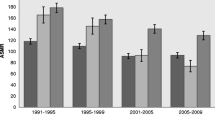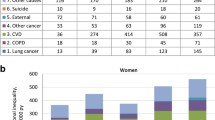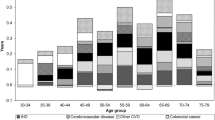Abstract
Objectives
To gain insight into the evolution in educational inequalities in adolescent and young adult all-cause and cause-specific mortality in the urban setting of the Brussels-Capital Region.
Methods
Data were derived from record linkage between the censuses of 1991 and 2001 and register data on all-cause and cause-specific mortality and emigration in the respective periods of 1st October 1991 to 1st January 1996 and 1st October 2001 to 1st January 2006. Both directly and indirectly standardised mortality rates and the relative index of inequality (RII) were computed.
Results
Mortality rates among adolescents and young adults have dropped significantly, especially infections and traffic accidents. However, educational inequalities among men have slightly increased: men with a maximum primary education are four times more likely to die than those who are higher educated [RII = 4.09 (2.78–6.03)]. Among women, no social gradient is observed in either period, but a clear split between the lowest educated and other educational groups is apparent in the 2000s.
Conclusions
There is a positive evolution towards lower mortality among adolescents and young adults, but educational inequalities remain a public health concern.
Résumé
Objectifs
Établir un aperçu de l’évolution de l’inégalité selon le niveau d’instruction dans la mortalité générale et par cause des adolescents et des jeunes adultes dans les zones urbaines de la Région de Bruxelles-Capitale.
Méthodes
Les données proviennent d’un couplage entre les recensements de 1991 et de 2001 avec les données du Registre Nationale sur la mortalité (générale et par cause) et sur l’émigration des périodes 01/10/1991-01/01/1996 et 01/10/2001- 01/01/2006. Nous avons utilisés les taux de mortalité standardisés (directs et indirects) et l’indice relatif d’inégalité (RII)
Résultats
Les taux de mortalité des adolescents et des jeunes adultes ont nettement baissé. Les incidences des infections et des accidents de la circulation ont particulièrement diminué. Cependant, les inégalités selon le niveau d’instruction chez les hommes ont légèrement augmenté: la mortalité des hommes avec niveau d’études primaires ou moins est quatre fois plus élevée que la mortalité des plus instruits (RII = 4,09 [2,78 à 6,03]). Chez les femmes, nous n’avons observé aucun gradient social dans aucune des périodes étudiées, mais un net clivage entre les groupes moins instruits et le reste des femmes apparait dans les années 2000.
Conclusion
Il y a une évolution vers une plus faible mortalité chez les adolescents et les jeunes adultes, mais l’inégalité selon le niveau d’instruction restent une préoccupation de santé publique.
Similar content being viewed by others
References
Anderson RN, Miniño AM, Hoyert DL, Rosenberg HM (2001) Comparability of cause of death between ICD-9 and ICD-10: preliminary estimates. Natl Vital Stat Rep 49:1–32
Baeten G (2001) The Europeanization of Brussels and the urbanization of Europe. Hybridizing the city. Empowerment and disempowerment in the EU district. Eur Urban Reg Stud 8(2):117–130
Bleyer A, Viny A, Barr R (2006) Cancer in 15- to 29-year-olds by primary site. Oncologist 11:590–601. doi:10.1634/theoncologist.11-6-590
Blum RW (2009) Young people: not as healthy as they seem. Lancet 374:852–854
Borrell C, Pasarin MI, Cirera E, Klutke P, Pipitone E, Plasencia A (2001) Trends in young adult mortality in three European cities: Barcelona, Bologna and Munich, 1986–1995. J Epidemiol Community Health 55:577–582
Borrell C, Rodríguez M, Ferrando J, Brugal MT, Pasarín MI, Martínez V, Plaséncia A (2002) Role of individual and contextual effects in injury mortality: new evidence from small area analysis. Inj Prev 8:297–302
Casteels Y, Scheers M (2008) Evolution of road safety in Belgium 2000–2006. Belgian Institute of Road Safety (BIVV), Brussels
Cesaroni G, Agabiti N, Forastiere F, Ancona C, Perucci CA (2006) Socioeconomic differentials in premature mortality in Rome: changes from 1990 to 2001. BMC Public Health. doi:10.1186/1471-2458-6-270
Cubbin C, Smith GS (2002) Socioeconomic inequalities in injury: critical issues in design and analysis. Annu Rev Public Health 23:349–375
De Grande H (2013) Evolution of mortality patterns by nationality of origin among adolescents and young adults living in the Brussels-Capital Region. Forthcoming working paper
De Spiegelaere M, Closon M, Deboosere P, Humblet P (2009) Health and quality of life in Brussels. Brussels Stud, Synthesenota 11:1–11
Deboosere P, Eggerickx T, Van Hecke E, Wayens B (2009) The population of Brussels: a demographic screening. Brussels Stud, Synthesenota 3:1–16
Due P, Krølner R, Rasmussen M, Andersen A, Trab Damsgaard M, Graham H, Holstein BE (2011) Pathways and mechanisms in adolescence contribute to adult health inequalities. Scand J Public Health 39:62–78. doi:10.1177/1403494810395989
Galobardes B, Lynch J, Smith GD (2007) Measuring socioeconomic position in health research. Br Med Bull 81:21–37
Gore FM, Bloem PJ, Patton GC, Ferguson J, Joseph V, Coffey C, Sawyer SM, Mathers CD (2011) Global burden of disease in young people aged 10–24 years: a systematic analysis. Lancet 377:2093–2102. doi:10.1016/S0140-6736(11)60512-6
Hasselberg M, Laflamme L (2008) Road traffic injuries among young car drivers by country of origin and socioeconomic position. Int J Public Health 53:40–45
Jacobs D, Rea A (2007) Being young in Brussels, between diversity and adversity. Survey among senior students of Brussels’ city schools. Brussels Stud 8:1–19
Koivusilta LK, Rimpela AH, Kautiainen SM (2006) Health inequality in adolescence. Does stratification occur by familial social background, family affluence, or personal social position? BMC Public Health 6:110. doi:10.1186/1471-2458-6-110
Koskinen S, Martelin T (1994) Why are socioeconomic mortality differences smaller among women than among men? Soc Sci Med 38:1385–1396
Krug EG, Sharma GK, Lozano R (2000) The global burden of injuries. Am J Public Health 90:523–526
Kunst A, Mackenbach JP (1994) The size of mortality differences associated with educational level in nine industrialized countries. Am J Public Health 84:932–937
Kunst A, Bos V, Mackenbach J (2001) Monitoring socio-economic inequalities in health in the European Union: guidelines and illustrations. Department of Public Health, Rotterdam
Ma J, Xu J, Anderson RN, Jemal A (2012) Widening educational disparities in premature death rates in twenty six states in the United States, 1993–2007. PLoS One. doi:10.1371/journal.pone.0041560
Mackenbach JP, Kunst AE (1997) Measuring the magnitude of socio-economic inequalities in health: an overview of available measures illustrated with two examples from Europe. Soc Sci Med 44:757–771
Mäki N (2010) Not in all walks of life? Social differences in suicide mortality. Dissertation, Helsinki
Marmot (2004) The status syndrome: how social status affects our health and longevity. Owl Books, New York
Marmot M (2009) Social determinants and adolescent health. Int J Public Health 54:125–127
Palella FJ Jr, Delaney KM, Moorman AC, Loveless MO, Fuhrer J, Satten GA, Aschman DJ, Holmberg SD and the HIV outpatient study investigators (1998) Declining morbidity and mortality among patients with advanced human immunodeficiency virus infection. New Engl J Med 338:853–860
Phelan JC, Link BG, Diez-Roux A, Kawachi I, Levin B (2004) “Fundamental causes” of social inequalities in mortality: a test of the theory. J Health Soc Behav 45:265–285
EU Regional Policy (2011) Cities of tomorrow. Challenges, visions, ways forward. Brussels: European Commission
Polinder S, Haagsma JA, Toet H, Brugmans MJP, van Beeck F (2010) Burden of injury in childhood and adolescence in 8 European countries. BMC Public Health 10:1. doi:10.1186/1471-2458-10-45
Remes RH, Martikainen MP, Valkonen VT (2010) Mortality inequalities by parental education among children and young adults in Finland 1990–2004. J Epidemiol Community Health 64:130–135
Richter M, Vereecken CA, Boyce W, Maes L, Gabhainn SN, Currie CE (2009) Parental occupation, family affluence and adolescent health behaviour in 28 countries. Int J Public Health 54:4. doi:10.1007/s00038-009-8018-4
Saurel-Cubizolles MJ, Chastang JF, Menvielle G, Leclerc A, Luce D (2009) Social inequalities in mortality by cause among men and women in France. J Epidemiol Community Health 63:197–202
Sethi D, Racioppi F, Baumgarten I, Bertollini R (2007) Reducing inequalities from injuries in Europe. Lancet 368:2243–2250
Shkolnikov VM, Jasilionis D, Andreev EM, Jdanov DA, Stankuniene V, Ambrozaitiene D (2007) Linked versus unlinked estimates of mortality and length of life by education and marital status: evidence from the first record linkage study in Lithuania. Soc Sci Med 64:1392–1406. doi:10.1016/j.socscimed.2006.11.014
UNESCO (2011) Revision of the International Standard Classification of Education. Paris: UNESCO. Rep nr. 36/C19
Valkonen T (1993) Problems in the measurement and international comparison of socio-economic differences in mortality. Soc Sci Med 36:409–418
van Lenthe FJ, de Bourdeaudhuij I, Klepp KI, Lien N, Moore L, Faggiano F, Kunst AE, Mackenbach JP (2009) Preventing socioeconomic inequalities in health behaviour in adolescents in Europe: background, design and methods of project TEENAGE. Public Health 9:125. doi:10.1186/1471-2458-9-125
Viner RM, Coffey C, Mathers C, Bloem P, Costello A, Santelli J, Patton GC (2011) 50-year mortality trends in children and young people: a study of 50 low-income, middle-income, and high-income countries. Lancet 877:1162–1174
Wagstaff A, Paci P, Van Doorslaer E (1991) On the measurement of inequalities in health. Soc Sci Med 33:545–557
West P, Sweeting H (2004) Evidence on equalisation in health in youth from the west of Scotland. Soc Sci Med 59:13–27
Acknowledgments
This study was funded by Innoviris with the Prospective Research for Brussels programme, an initiative of the government of the Brussels-Capital Region. We are thankful to the Brussels-Capital Health and Social Observatory for their methodological help and interesting discussions of the results. Also, many thanks go to Sylvie Gadeyne for her ever-inspiring comments.
Author information
Authors and Affiliations
Corresponding author
Appendix 1
Appendix 1
See Table 6.
Rights and permissions
About this article
Cite this article
De Grande, H., Deboosere, P. & Vandenheede, H. Evolution of educational inequalities in mortality among young adults in an urban setting. Int J Public Health 58, 825–835 (2013). https://doi.org/10.1007/s00038-013-0478-x
Received:
Revised:
Accepted:
Published:
Issue Date:
DOI: https://doi.org/10.1007/s00038-013-0478-x




